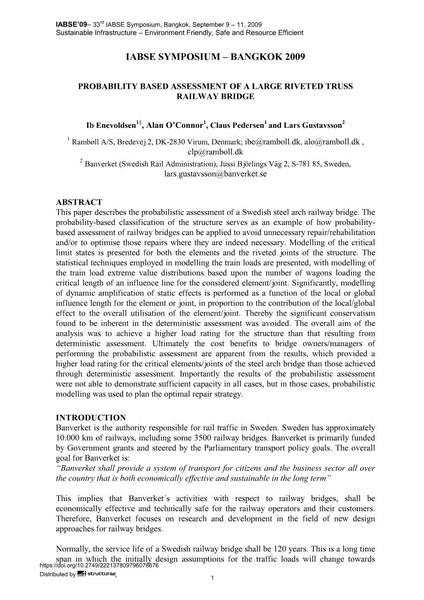Probability Based Assessment of a Large Riveted Truss Railway Bridge

|
|
|||||||||||
Détails bibliographiques
| Auteur(s): |
Ib Enevoldsen
Alan O'Connor Claus Pedersen Lars Gustavsson |
||||
|---|---|---|---|---|---|
| Médium: | papier de conférence | ||||
| Langue(s): | anglais | ||||
| Conférence: | IABSE Symposium: Sustainable Infrastructure - Environment Friendly, Safe and Resource Efficient, Bangkok, Thailand, 9-11 September 2009 | ||||
| Publié dans: | IABSE Symposium Bangkok 2009 | ||||
|
|||||
| Page(s): | 27-35 | ||||
| Nombre total de pages (du PDF): | 9 | ||||
| Année: | 2009 | ||||
| DOI: | 10.2749/222137809796078676 | ||||
| Abstrait: |
This paper describes the probabilistic assessment of a Swedish steel arch railway bridge. The probability-based classification of the structure serves as an example of how probability- based assessment of railway bridges can be applied to avoid unnecessary repair/rehabilitation and/or to optimise those repairs where they are indeed necessary. Modelling of the critical limit states is presented for both the elements and the riveted joints of the structure. The statistical techniques employed in modelling the train loads are presented, with modelling of the train load extreme value distributions based upon the number of wagons loading the critical length of an influence line for the considered element/joint. Significantly, modelling of dynamic amplification of static effects is performed as a function of the local or global influence length for the element or joint, in proportion to the contribution of the local/global effect to the overall utilisation of the element/joint. Thereby the significant conservatism found to be inherent in the deterministic assessment was avoided. The overall aim of the analysis was to achieve a higher load rating for the structure than that resulting from deterministic assessment. Ultimately the cost benefits to bridge owners/managers of performing the probabilistic assessment are apparent from the results, which provided a higher load rating for the critical elements/joints of the steel arch bridge than those achieved through deterministic assessment. Importantly the results of the probabilistic assessment were not able to demonstrate sufficient capacity in all cases, but in those cases, probabilistic modelling was used to plan the optimal repair strategy. |
||||
